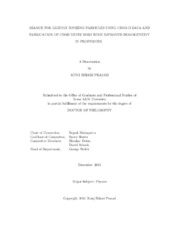| dc.description.abstract | Fundamental particles are always observed to carry charges which are integral multiples of one-third charge of electron, e /3. While this is a well-established experimental fact, the theoretical understanding for the charge quantization phenomenon is lacking. On the other hand, there exist numerous theoretical models that naturally allow for existence of particles with fractional electromagnetic charge. These particles, if existing, hint towards existence of physics beyond the standard model. Multiple high energy, optical, cosmological and astrophysical considerations restrict the allowable mass-charge parameter space for these fractional charges. Still, a huge unexplored region remains.
The Cryogenic Dark Matter Search (CDMS-II), located at Soudan mines in northern Minnesota, employs germanium and silicon crystals to perform direct searches for a leading candidate to dark matter called Weakly Interacting Massive Particles (WIMPs). Alternately, the low detection threshold allows search for fractional electromagnetic-charged particles, or Lightly Ionizing Particles (LIPs), moving at relativistic speed. Background rejection is obtained by requiring that the magnitude and location of energy deposited in each detector be consistent with corresponding “signatures” resulting from the passage of a fractionally charged particle. In this dissertation, the CDMS-II data is analyzed to search for LIPs, with an expected background of 0.078±0.078 events. No candidate events are observed, allowing exclusion of new parameter space for charges between e /6 and e /200.
With primary aim to increase sensitivity to detect WIMPs, it is necessary to expand the detector count and mass by more than two orders of magnitude over CDMS-II. This also increases sensitivity to detect LIPs. It becomes imperative to obtain repeatability in the detection sensor quality over multiple detectors. In this dissertation, we also describe the improvements and process flow optimizations implemented to obtain higher yield in fabrication of useful detectors with homogeneous sensor properties within each detector and among different batches. It also allows for reduction in fabrication time, cost and removal of avoidable cost-intensive steps like ion-implantation. Most important is the control in obtaining tungsten thin film with desired superconducting transition temperature and improvements in photolithographic steps for sensor fabrication. | en |


